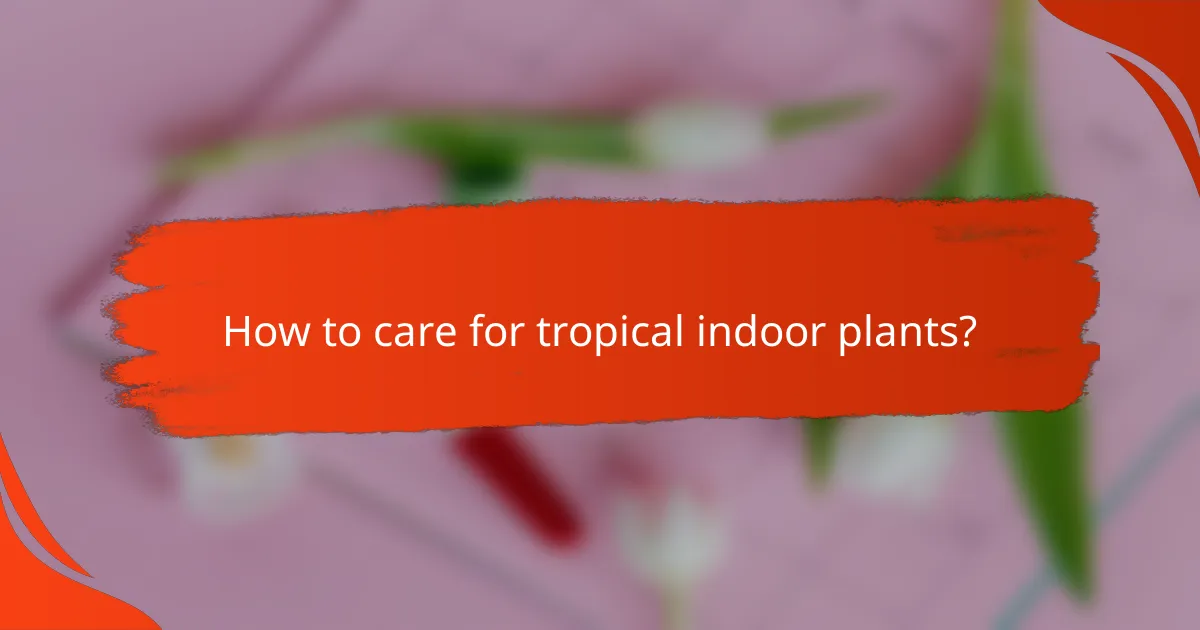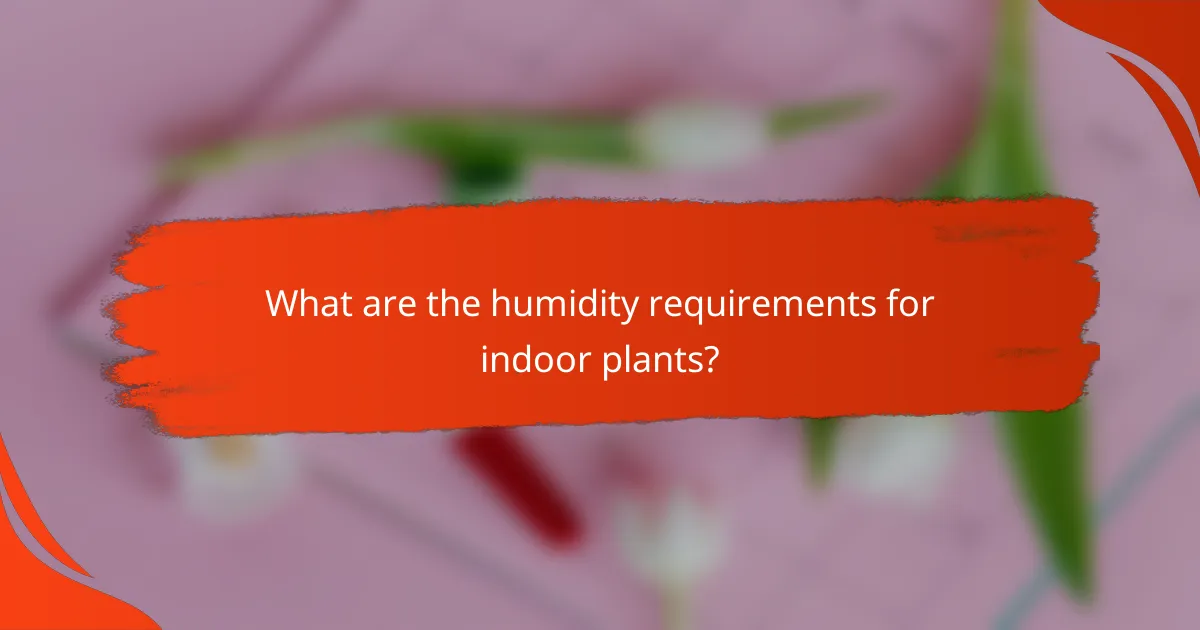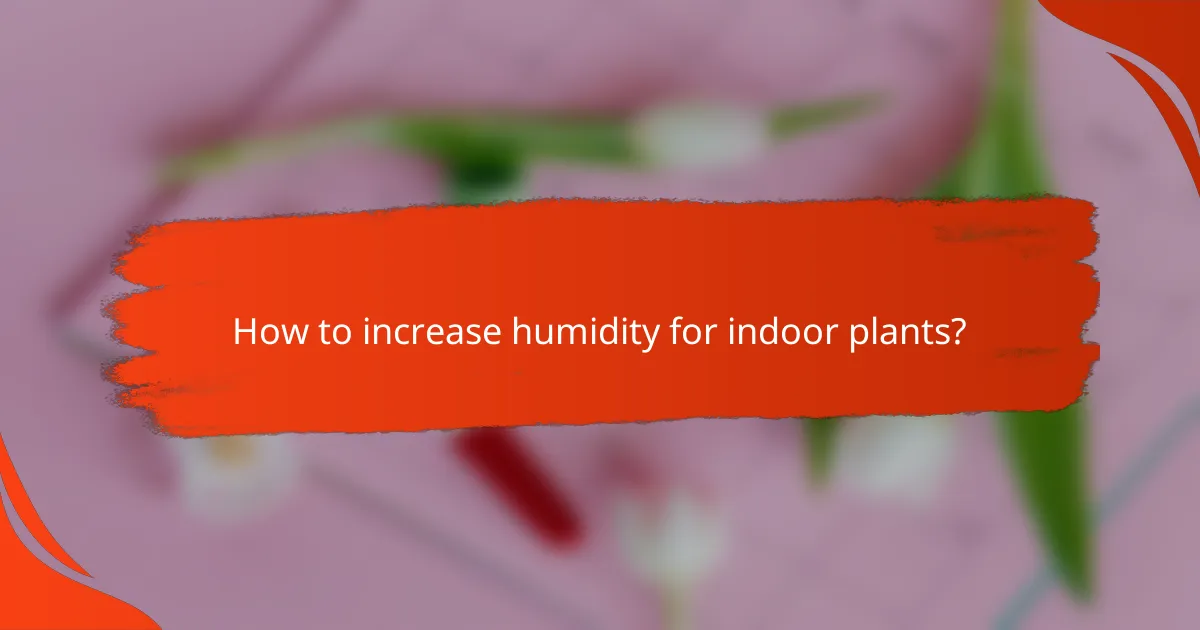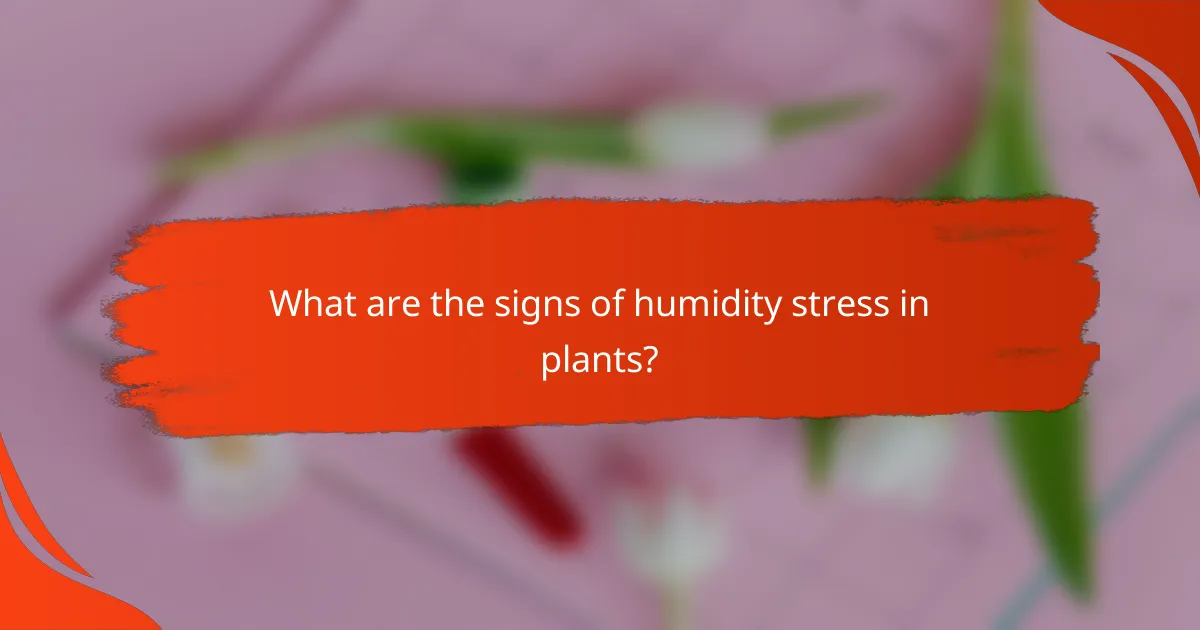Indoor plants that flourish in high humidity often hail from tropical regions, requiring consistent moisture to thrive. By understanding their specific care needs, including water, light, and humidity levels, you can create an optimal environment that enhances both the beauty of your space and the air quality within it.

Which indoor plants thrive in high humidity?
Indoor plants that thrive in high humidity typically originate from tropical environments. These plants often require consistent moisture in the air to flourish and can enhance the aesthetic of your indoor space while improving air quality.
Ferns
Ferns are excellent choices for high humidity environments, as they naturally thrive in moist, shaded areas. Popular varieties like Boston ferns and Maidenhair ferns prefer humidity levels above 50% and can be easily grown in bathrooms or kitchens.
To care for ferns, keep the soil consistently moist but not soggy. Mist the leaves regularly to maintain humidity, and avoid placing them in direct sunlight, which can scorch their delicate fronds.
Peace Lily
The Peace Lily is a resilient plant that flourishes in high humidity and low light conditions. It can tolerate humidity levels ranging from 40% to 60%, making it suitable for various indoor settings.
For optimal care, water the Peace Lily when the top inch of soil feels dry. It also benefits from regular misting and should be kept away from drafts and direct sunlight to prevent leaf burn.
Calathea
Calathea plants are known for their striking foliage and thrive in humid environments, often preferring humidity levels above 60%. They are native to tropical regions, which makes them well-suited for indoor spaces with high moisture.
To care for Calathea, keep the soil consistently moist and use distilled water to avoid leaf spots from tap water. Regular misting is essential, and placing them in indirect light will help maintain their vibrant colors.
Orchid
Orchids, particularly Phalaenopsis, thrive in high humidity and can benefit from levels around 50% to 70%. These elegant plants require specific care to ensure they bloom beautifully indoors.
Provide orchids with well-draining potting media and water them when the roots appear silvery. Using humidity trays or misting can help maintain the necessary moisture levels, and they should be placed in bright, indirect light for optimal growth.
Spider Plant
Spider Plants are adaptable and can thrive in various humidity levels, but they perform best in environments with higher moisture. They are resilient and can tolerate fluctuations in humidity, making them a great choice for beginners.
To care for Spider Plants, water them when the top inch of soil is dry, and mist occasionally to boost humidity. They prefer bright, indirect light but can also adapt to lower light conditions, making them versatile for different indoor spaces.

How to care for tropical indoor plants?
Caring for tropical indoor plants involves understanding their specific needs for water, light, humidity, and nutrients. By providing the right conditions, you can ensure these plants thrive in your home environment.
Regular watering
Tropical indoor plants generally prefer consistently moist soil, but overwatering can lead to root rot. Water these plants when the top inch of soil feels dry, ensuring that excess water drains away to prevent soggy roots.
During the growing season, which is typically spring and summer, you may need to water more frequently, while in the fall and winter, reduce watering as the plants enter a dormant phase. A good rule of thumb is to check the soil moisture weekly.
Proper lighting
Most tropical plants thrive in bright, indirect light. Direct sunlight can scorch their leaves, so position them near a window with filtered light or use sheer curtains to diffuse the rays.
If natural light is limited, consider using grow lights to supplement their light needs. Aim for around 12-16 hours of light per day to promote healthy growth.
Humidity maintenance
Tropical plants require higher humidity levels, typically between 50-70%. You can increase humidity by misting the plants regularly, placing a humidifier nearby, or grouping plants together to create a microclimate.
Another effective method is to place the pots on trays filled with pebbles and water, ensuring the pots are not submerged. This setup allows evaporation to raise the humidity around the plants.
Fertilization schedule
Fertilizing tropical indoor plants is essential for their growth, especially during the active growing season. Use a balanced liquid fertilizer every 4-6 weeks to provide necessary nutrients.
In the fall and winter, reduce or stop fertilization as the plants slow their growth. Always follow the manufacturer’s instructions for dilution and application rates to avoid over-fertilizing, which can harm the plants.

What are the humidity requirements for indoor plants?
Indoor plants have varying humidity requirements that significantly affect their growth and health. Understanding these needs helps in creating an optimal environment for your plants, ensuring they thrive indoors.
Low humidity tolerance
Plants with low humidity tolerance can survive in drier conditions, typically around 30-50% humidity. Succulents and cacti are prime examples, as they have adapted to arid environments.
To care for low-humidity plants, ensure they are placed in well-draining soil and avoid overwatering. Regularly check their moisture levels, as these plants prefer to dry out between waterings.
Moderate humidity preference
Moderate humidity preference plants thrive in environments with humidity levels ranging from 40-60%. Common examples include snake plants and pothos, which can adapt to various indoor conditions.
To maintain their health, consider using a humidity meter to monitor levels. Grouping these plants together can help create a microclimate that retains moisture, benefiting all plants in the vicinity.
High humidity needs
Plants that require high humidity typically need levels above 60%, with many tropical species thriving in 70-90% humidity. Examples include ferns and orchids, which are native to humid environments.
To meet their needs, consider using a humidifier, misting them regularly, or placing them on a pebble tray filled with water. Be cautious of overwatering, as high humidity can lead to root rot if the soil remains too wet.

How to increase humidity for indoor plants?
To increase humidity for indoor plants, consider methods that create a more moisture-rich environment. This can enhance plant health, promote growth, and reduce stress on tropical species that thrive in high humidity.
Use a humidifier
A humidifier is one of the most effective ways to boost humidity levels for indoor plants. By adding moisture to the air, it creates an ideal environment for tropical plants that prefer humidity levels between 50% and 70%.
When selecting a humidifier, look for one that can cover the size of your space. Regularly monitor humidity levels with a hygrometer to ensure they remain within the optimal range for your plants.
Group plants together
Grouping plants together can naturally increase humidity through transpiration, where plants release moisture into the air. This method works best with tropical plants that require higher humidity.
Consider placing plants close to each other on a shelf or table. The combined moisture from their leaves can create a microclimate that benefits all the grouped plants.
Pebble trays
Pebble trays are a simple and effective way to increase humidity around specific plants. Fill a shallow tray with pebbles and add water until it just covers the pebbles, ensuring that the plant pots sit above the water level.
As the water evaporates, it will raise the humidity around the plants. Refill the tray as needed, and regularly check for algae growth to maintain a healthy environment.
Bathroom placement
Placing humidity-loving plants in the bathroom can be beneficial due to the naturally higher moisture levels from showers and baths. This is especially effective for plants like ferns and orchids that thrive in humid conditions.
Ensure the bathroom has adequate light, either from windows or grow lights, to support plant growth while enjoying the humidity benefits. Regularly rotate plants to ensure even light exposure if they are not receiving sufficient natural light.

What are the signs of humidity stress in plants?
Signs of humidity stress in plants include wilting leaves, browning leaf tips, and leaf drop. These symptoms indicate that the plant is not receiving adequate moisture in the air, which is crucial for its overall health.
Common symptoms of humidity stress
Common symptoms of humidity stress include curling leaves, dry leaf edges, and stunted growth. Plants may also exhibit yellowing leaves or become more susceptible to pests and diseases. Recognizing these signs early can help in taking corrective measures.
How humidity affects plant health
Humidity plays a critical role in plant health as it influences transpiration, nutrient uptake, and overall growth. Low humidity can lead to excessive water loss, causing stress and making plants vulnerable to environmental changes. Conversely, high humidity can promote fungal diseases and root rot.
Tips for managing humidity levels
To manage humidity levels effectively, consider using a humidifier, especially in dry indoor environments. Grouping plants together can also create a microclimate with higher humidity. Regularly misting plants or placing water trays nearby can help maintain moisture in the air.
Plants that thrive in high humidity
Tropical plants such as ferns, orchids, and peace lilies thrive in high humidity environments. These plants typically require humidity levels above 50% to flourish. When selecting indoor plants, consider their humidity preferences to ensure they remain healthy and vibrant.

